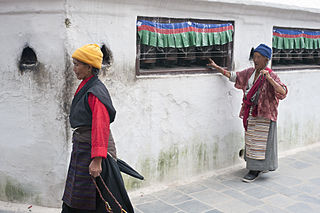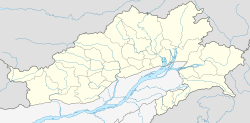
Arunachal Pradesh is a state in northeast India. It was formed from the North-East Frontier Agency (NEFA) region, and India declared it as a state on 20 February 1987. Itanagar is its capital and largest town. It borders the Indian states of Assam and Nagaland to the south. It shares international borders with Bhutan in the west, Myanmar in the east, and a disputed 1,129 km border with China's Tibet Autonomous Region in the north at the McMahon Line. Arunachal Pradesh is claimed by China as South Tibet as part of the Tibet Autonomous Region; China occupied some regions of Arunachal Pradesh in 1962 but later withdrew its forces.

The McMahon Line is the boundary between Tibet and British India as agreed in the maps and notes exchanged by the respective plenipotentiaries on 24–25 March 1914 at Delhi, as part of the 1914 Simla Convention. The line delimited the respective spheres of influence of the two countries in the eastern Himalayan region along northeast India and northern Burma (Myanmar), which were earlier undefined. The Republic of China was not a party to the McMahon Line agreement, but the line was part of the overall boundary of Tibet defined in the Simla Convention, initialled by all three parties and later repudiated by the government of China. The Indian part of the Line currently serves as the de facto boundary between China and India, although its legal status is disputed by the People's Republic of China. The Burmese part of the Line was renegotiated by the People's Republic of China and Myanmar.
The Nah people are a small tribal group residing in the Indian state of Arunachal Pradesh. They speak the Na_dialect, a member of the Sino-Tibetan language family, in which the population's literacy rate is 30%. The Na language has an affinity with the Tagin language. They also use Hindi or English. As of 2000, the tribal population stood at 1,500.

Upper Subansiri (Pron:/su:bənˈsɪɹi/) is an administrative district in the state of Arunachal Pradesh in India.

Tawang is a town and administrative headquarter of Tawang district in the Indian state of Arunachal Pradesh. It lies on NH-13 section of Trans-Arunachal Highway. The town was once the headquarter of the Tawang Tract, which is now divided into the Tawang district and the West Kameng district. Tawang continues as the headquarters of the former. Tawang is the number one tourist destination of Arunachal Pradesh.

Walong is an administrative town and the headquarters of eponymous circle in the Anjaw district in eastern-most part of Arunachal Pradesh state in India. It also has a small cantonment of the Indian Army. Walong is on banks of Lohit River, which enters India 35 km north of Walong at India-China LAC at Kaho pass.

Kora is a transliteration of a Tibetan word that means "circumambulation" or "revolution". Kora is both a type of pilgrimage and a type of meditative practice in the Tibetan Buddhist or Bon traditions. A Kora is performed by the practitioner making a circumambulation around a sacred site or object, typically as a constituent part of a pilgrimage, ceremony, celebration or ritual. In broader terms, it is a term that is often used to refer to the entire pilgrimage experience in the Tibetan regions.
Yume or Yümé, also spelt Yümai (Tibetan: ཡུལ་སྨད་, Wylie: yul smad, THL: yül mé), is a township in the Lhuntse County in Tibet region of China. Yume is on the bank of the Yume Chu river, a tributary of the Subansiri River, which it joins the China–India border close to Taksing. The township is part of the Tsari district, considered holy by Tibetans.

Mechukha or Menchukha is a town, assembly constituency and subdivision, situated 6,000 feet (1,829 m) above sea level in the Mechukha Valley of Yargep Chu/ Siyom River in Shi Yomi district of Arunachal Pradesh state of India. Before the 1950s, Mechuka valley was known as Pachakshiri.

The Subansiri is a trans-Himalayan river and a tributary of the Brahmaputra River that flows through Tibet's Lhuntse County in the Shannan Prefecture, and the Indian states of Arunachal Pradesh and Assam. The Subansiri is approximately 518 kilometres (322 mi) long, with a drainage basin 32,640 square kilometres (12,600 sq mi). It is the largest tributary of the Brahmaputra contributing 7.92% of the Brahmaputra's total flow.
Chaglagam is a village and the headquarters of an eponymous circle in the Anjaw district in the north-eastern state of Arunachal Pradesh, India. It is on the bank of the Delei River.
Milakatong La or Menlakathong La is a historic mountain pass along the trade route between Tawang in India's Arunachal Pradesh and Tsona Dzong in Tibet's Shannan province via the valley of Tsona Chu.

Gelemo or Gelomo (full name: Gelomoring) is a border village in the Upper Subansiri district, Arunachal Pradesh, India. It is on the bank of the Tsari Chu river before its confluence with the Subansiri River, at a distance of "two days march" from the Indian claimed border at Longju. The present Line of Actual Control between China and India is at roughly half that distance.

Taksing is a village and headquarters of an eponymous Circle in the Upper Subansiri district, Arunachal Pradesh, India. The region of Taksing is populated by Tagin people.

Dakpa Sheri (Tibetan: དག་པ་ཤེལ་རི, Wylie: dag pa shel ri, THL: dak pa shel ri, Chinese: 达瓜西热; pinyin: Dá guā xī rè), explained as "Pure Crystal Mountain" and also known as Tsari, is a mountain in the eponymously named Tsari region in Lhöntse County of Tibet's Shannan Prefecture. The mountain is considered sacred for Tibetans and the pilgrimage route circumambulates the mountain. Takpa Siri ridge consists of four hills/ passes and four water bodies.
Longju or Longzu is a disputed area in the eastern sector of the China–India border, controlled by China but claimed by India. The village of Longju is located in the Tsari Chu valley 2.5 kilometres (1.6 mi) south of the town of Migyitun, considered the historical border of Tibet. The area of Longju southwards is populated by the Tagin tribe of Arunachal Pradesh.
Gelensiniak, or Geling Sinyik, is a village in the Limeking Circle of the Upper Subansiri district in Arunachal Pradesh, India, close to the region's border with Tibet. The Gelen or Gelling river flows down from Migyitun and Longju and joins the Subansiri River here. Gelensiniak is strategically located between Longju, Taksing and Limeking. The region is populated by the Mara clan of Tagin people.
Asaphila or Asafila is a mountainous forest area near the China–India border along the Subansiri River valley. It is at the southwestern corner of the Tsari region, straddling Lhünzê County in the Shannan Prefecture of Tibet, and the Taksing Circle in the Upper Subansiri district of Arunachal Pradesh, India. Occasional border disputes between the two countries in the region are reported.

Rima is the former capital of the Zayul in the southeastern Tibet Autonomous Region of China. It is on the border with India's Arunachal Pradesh at the confluence of the Rongto Chu and Zayul Chu rivers, which join to form the Zayul River before it flows into Arunachal Pradesh. Rima was a notable border trading town, which the British contemplated as a location for a trade mart in the Lhasa Convention.
Tulung La (Tibetan: ཐུ་ལུང་ལ་, Wylie: thu lung la) is a border pass between the Tsona County in the Tibet region of China and India's Tawang district in Arunachal Pradesh. It is in the eastern part of the two districts, close to the Gori Chen cluster of mountains, on a watershed between the Tsona Chu river in Tibet and the Tawang Chu in the Tawang district. The watershed ridge forms the border between Tibet and India as per the McMahon Line. Tulung La provided an invasion route to China during the 1962 Sino-Indian War. It is also the scene of occasional clashes between the two sides.














